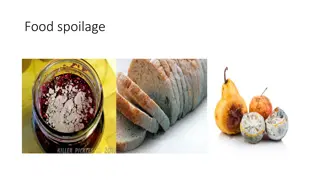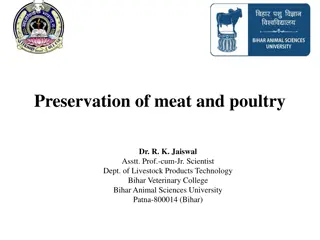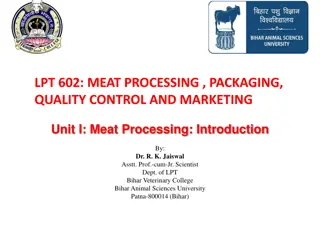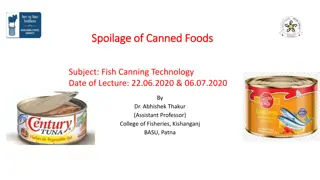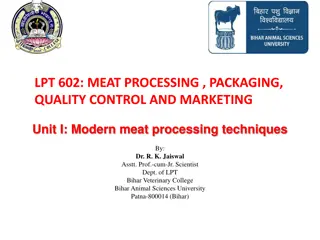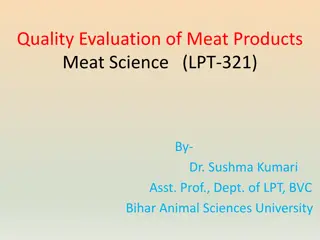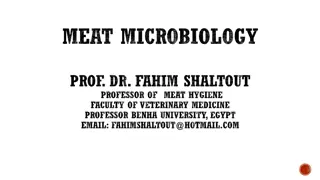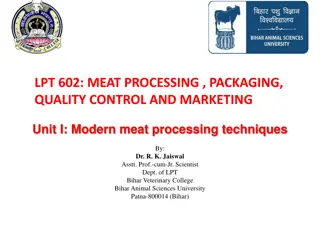Understanding the Spoilage Flora in Raw Meat Products
Raw meat products are highly perishable due to the presence of various spoilage bacteria, yeasts, and molds. Factors such as nutrient availability, oxygen levels, storage temperature, and pH influence the predominant spoilage flora in meat. Psychrotrophic bacteria thrive in refrigerated storage, leading to off odors, slime, and color changes in meats. Different types of bacteria and molds contribute to spoilage, causing undesirable odors, discoloration, and putrefaction. Understanding these spoilage mechanisms is crucial for maintaining meat quality and safety.
Download Presentation

Please find below an Image/Link to download the presentation.
The content on the website is provided AS IS for your information and personal use only. It may not be sold, licensed, or shared on other websites without obtaining consent from the author. Download presentation by click this link. If you encounter any issues during the download, it is possible that the publisher has removed the file from their server.
E N D
Presentation Transcript
A. Raw Meat Meats are the most perishable of all important foods. Meats contain a large quantity of all nutrients required for the growth of bacteria, yeasts, and molds. Fresh meats from food animals and birds contain a large group of potential spoilage bacteria that include species of Pseudomonas, Acinetobacter, Moraxella, Shewanella, Alcaligenes, Aeromonas, Escherichia, Enterobacter, Serratia, Hafnia, Proteus, Brochothrix, Micrococcus, Enterococcus, Lactobacillus, Leuconostoc, Carnobacterium, and Clostridium, as well as yeasts and molds.
The predominant spoilage flora in a meat is determined by nutrient availability, oxygen availability, storage temperature, pH, storage time of the product, and generation time of the microorganisms present in a given environment. To delay microbial spoilage, fresh meats are stored at refrigerated temperature. Thus, normally psychrotrophic bacteria are the most predominant types in raw meat spoilage. Under aerobic storage at low temperature, growth of psychrotrophic aerobes and facultative anaerobes is favored.
In retail-cut meats, because of a shorter generation time, Pseudomonas spp. grows rapidly, using glucose first and then amino acids; the metabolism of amino acids is accompanied by the production of malodorous methyl sulfides, esters, and acids. In meats with high pH or low glucose content, or both, Acinetobacter and Morexella, which metabolize amino acids instead of glucose, can grow rapidly and produce undesirable odors. Spoilage by these strict aerobes in the form of off odor and slime . Along with offensive odors, some strains also produce H2S in small amounts to cause greening of the meat (H2S oxidizes myoglobin to a form of met myoglobin, causing a green discoloration).
Facultative anaerobic Enterobacter, Serratia, Proteus, and Hafnia species metabolize amino acids while growing in meat to produce amines, ammonia, methylsulfides, and mercaptans, and cause putrefaction. Because amines and ammonia are produced, the pH of the meat usually changes to alkaline range, and meat can have a pinkish to red color. Yeasts may grow under aerobic conditions on the meats and causes sliminess, lipolysis, off odors and tastes, discolorations (white, cream, pink or brown, due to pigments in yeasts).
Aerobic growth of molds may cause the following: 1-Stickiness:Growth of molds makes the surface of the meat sticky. 2- Discoloration :Black spot: Usually caused by Cladosporium . White spot: Caused by Geotrichum. Green patches: Caused by Penicillium spp. 3- Decomposition of Fats: Many molds have lipases an cause hydrolysis of fats. Molds also help in the oxidation of fats. 4-Off odor and off tastes: Molds give a musty flavor to meat.
To reduce spoilage of fresh meats, initial microbial level should be reduced. In addition, storage at low temperatures (close to 0 to 1C), modified atmosphere packaging, and vacuum packaging should be done. Several other methods to reduce initial microbial load and slow growth rate of Gram-negative rods are being either used or tested. These include the addition of small amounts of organic acids to lower the pH of meat (slightly above pH 5.0), drying of meat surfaces (to reduce aw), and a combination of the factors given , including lower storage temperature.
B. Processed Meat Products This group includes high-heat-processed and low- heat-processed uncured and cured meat products. High-heat-processed cured and uncured meats are given heat treatment to make them commercially sterile. Thus, they may only have some thermophilic spores surviving, which will not germinate unless the products are temperature abused. Low-heat-processed uncured meats, such as roasts, are given heat treatment at an internal temperature of (60 to 71C).
Generally, the surface of the meats (and thus most of the microorganisms) is exposed to the final temperature for 1 h or more, depending on the size of the meat. Under this condition, only the spores of Bacillus and Clostridium spp. and some thermoduric vegetative species (some Enterococcus, Micrococcus, Lactobacillus inside the product) can survive.
Many types of microorganisms can enter as post heat contaminants into the products from equipment, personnel, water, and air. In some situations, spices and other ingredients are added to the products after heating, which, in turn, can be the source of microbial contamination of the products. Some products are sliced before vacuum packaging, which increases the chances of contamination on the surface area of the product from the equipment and environment. Psychrotrophic facultative anaerobic and anaerobic bacteria have been implicated in the spoilage of these products.
Eggs: The hen s egg is an excellent example of a product that normally is well protected by its intrinsic parameters. Externally, a fresh egg has three structures, each effective to some degree in retarding the entry of microorganisms: the outer waxy shell membrane; the shell; and the inner shell membrane. Internally, lysozyme is present in egg white. This enzyme is quite effective against Gram-positive bacteria. Egg white also contains avidin, which forms a complex with biotin, that making this vitamin unavailable to microorganisms.
In addition, egg white has a high pH (about 9.3) and contains conalbumin, which forms a complex with iron, thus rendering it unavailable to microorganisms. On the other hand, the nutrient content of the yolk material and its pH in fresh eggs (about 6.8) make it an excellent source of growth for most microorganisms.
Freshly laid eggs are generally sterile. However, in a relatively short period of time after laying, numerous microorganisms may be found on the outside and, under the proper conditions, may enter eggs, grow, and cause spoilage. The speed at which microbes enter eggs is related to temperature of storage, age of eggs, and level of contamination. The use of CO2 to effect the rapid cooling of eggs led to fewer bacteria in the interior compared to conventional cooling.
The bacteria found in eggs were members of the following genera: Pseudomonas, Acinetobacter, Proteus, Aeromonas, Alcaligenes, Escherichia, Micrococcus, Salmonella, Serratia, Enterobacter, Flavobacterium, and Staphylococcus. Among the molds generally found are members of the genera Mucor, Penicillium, Cladosporium, and others; Torula is the only yeast found in eggs.
The most common form of bacterial spoilage of eggs is a condition known as rotting. Green rots are caused by Pseudomonas spp., especially fluorescens; colorless rots by Pseudomonas, Acinetobacter, and other species; black rots by Proteus, Pseudomonas, and Aeromonas; pink rots by Pseudomonas; red rots by Serratia spp., and custard rots by Proteus vulgaris and P. intermedium. Bacteria also cause a condition in eggs known as mustiness. Ex:Pseudomonas graveolens and Proteus spp.
Mold spoilage of eggs is generally referred to as pinspots, from the appearance of mycelial growth on the inside upon candling. Penicillium spp. and Cladosporium spp. are among the most common causes of pinspots and fungal rotting in eggs. The entry of microorganisms into whole eggs is favored by high humidity. More bacteria are found in egg yolk than in egg white, and the reason for a general lack of microorganisms in egg white is quite possibly its content of antimicrobial substances. In addition, upon storage, the thick white loses water to the yolk, resulting in a thinning of yolk and a shrinking of the thick white.
This phenomenon makes it possible for the yolk to come into direct contact with the inner membrane, where it may be infected directly by microorganisms. Once inside the yolk, bacteria grow in this nutritious medium, producing by products of protein and amino acid metabolism such as H2S and other foul-smelling compounds. The effect of significant growth is to cause the yolk to become runny and discolored. In regards to the destruction of salmonellae in boiled shell eggs, it is generally recognized that cooking until the entire yolk is solidified is sufficient to destroy S. enterica serotype Enteritidis.




